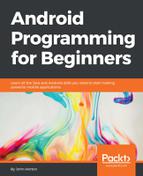Open up the
CaptureFragment.java file in the editor.
We need to add a new member variable for the CaptureFragment class to hold our new DataManager class instance.
Add the new highlighted member variable to CaptureFragment, which we have just discussed:
public class CaptureFragment extends Fragment{
private static final int CAMERA_REQUEST = 123;
private ImageView mImageView;
// Where the captured image is stored
private Uri mImageUri = Uri.EMPTY;
// Where to save the image
String mCurrentPhotoPath;
// A reference to our database
private DataManager mDataManager;
@Override
public void onCreate(Bundle savedInstanceState){
super.onCreate(savedInstanceState);
}Now, we can initialize the DataManager instance by adding this highlighted line of code to the onCreate method in CaptureFragment:
@Override
public void onCreate(Bundle savedInstanceState) {
super.onCreate(savedInstanceState);
mDataManager =
new DataManager(getActivity()
.getApplicationContext());
}Since our DataManager is coded and ready for use and we have an initialized instance of it, we can go ahead and implement the SAVE button. We already have a reference to all of the relevant EditText widgets as well as the Button widget via btnSave.
We can finish the job of saving our data in onCreateView by implementing an anonymous class to handle the button click. Inside the onClick method, we step through the following tasks:
- First, check that
mImageUrihas been initialized withif(mImageUri != null). - Next, check that the
mImageUrimember is not empty withif (!mImageUri.equals(Uri.EMPTY)). - Assuming we have a photo to save, we enter the
ifblock and declare a newPhotoobject. - Store the user's title by calling
setTitleand passing in the contents of themEditTextTitleEditText widget. - Store the URI by calling
setStorageLocationand passing inmImageUri. - Capture the user's values for each of the tags in three strings, and then use the appropriate setters of the
Photoclass to store them in thePhotoobject. - The last thing we do inside the
ifblock is to use ourDataManagerinstance to calladdPhoto,and of course, we pass in our just-constructedPhotoobject. TheDataManagerclass will add all the data into the required tables. - At the end of the
ifblock, we have anelseblock that delivers a pop-up message to the user if he or she tries to save a photo that doesn't exist or if it is successful.
Add the highlighted code in onCreateView, which we have just discussed, right after the code that handles the CAPTURE button:
// Listen for clicks on the capture button
btnCapture.setOnClickListener(new View.OnClickListener() {
...
...
});// End capture button handling
// Listen for clicks on the save button
btnSave.setOnClickListener(new View.OnClickListener() {
@Override
public void onClick(View v) {
if(mImageUri != null){
if(!mImageUri.equals(Uri.EMPTY)) {
// We have a photo to save
Photo photo = new Photo();
photo.setTitle(mEditTextTitle.getText().toString());
photo.setStorageLocation(mImageUri);
// What is in the tags
String tag1 = mEditTextTag1.getText().toString();
String tag2 = mEditTextTag2.getText().toString();
String tag3 = mEditTextTag3.getText().toString();
// Assign the strings to the Photo object
photo.setTag1(tag1);
photo.setTag2(tag2);
photo.setTag3(tag3);
// Send the new object to our DataManager
mDataManager.addPhoto(photo);
Toast.makeText(getActivity(), "Saved", Toast.LENGTH_LONG).show();
}else {
// No image
Toast.makeText(getActivity(), "No image to save", Toast.LENGTH_LONG).show();
}
}else {
// Uri not initialized
Log.e("Error ", "uri is null");
}
}
});
return view;
}// End onCreateViewWe could run the app at this point and actually begin to save photos to our database. The problem, of course, is that we don't yet have any way to see the list of available tags, photo titles, or any of the photos themselves.
Before TitlesFragment can respond to clicks and show a photo, we need a fragment to show those photos. So, let's code a fragment to view photos.
